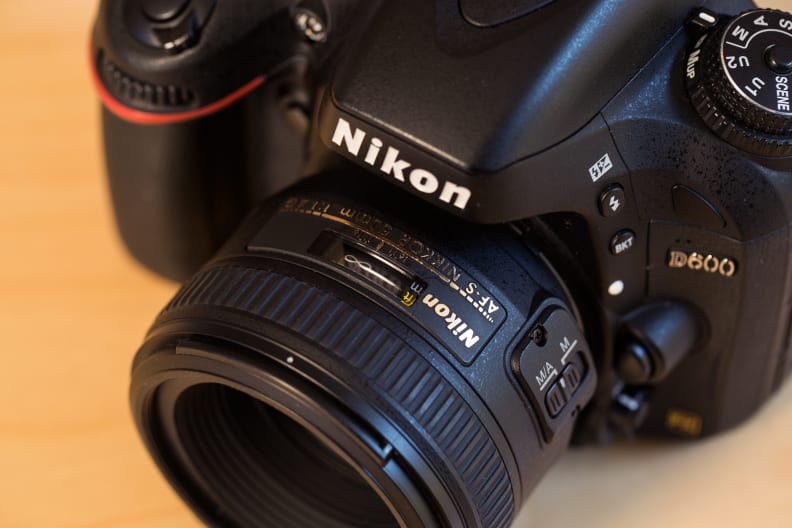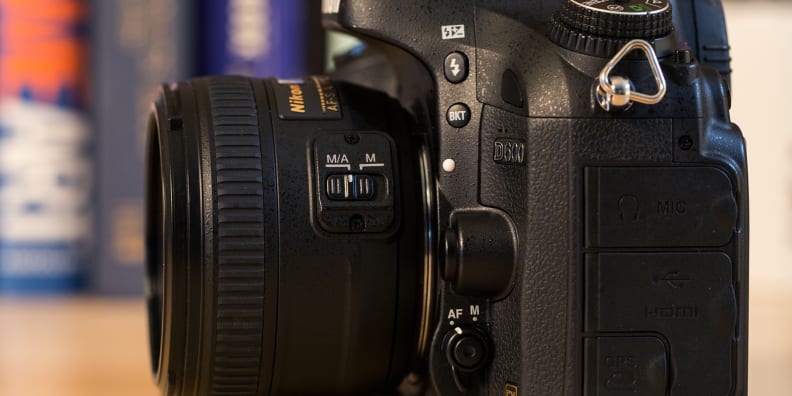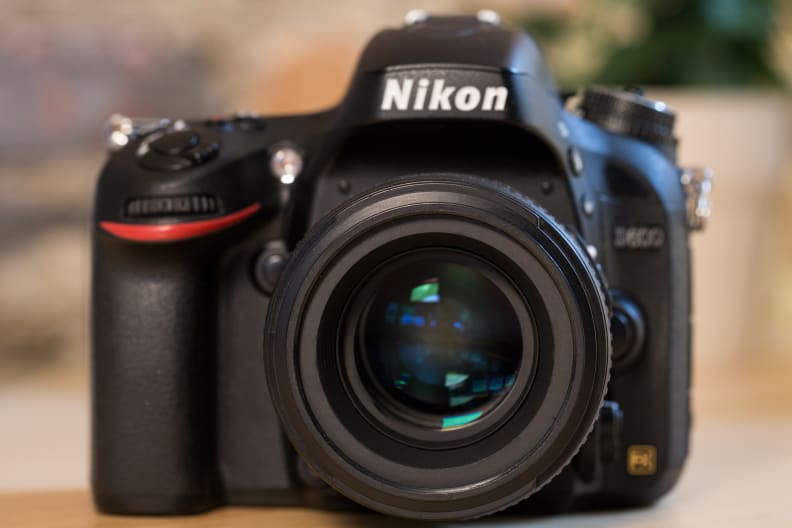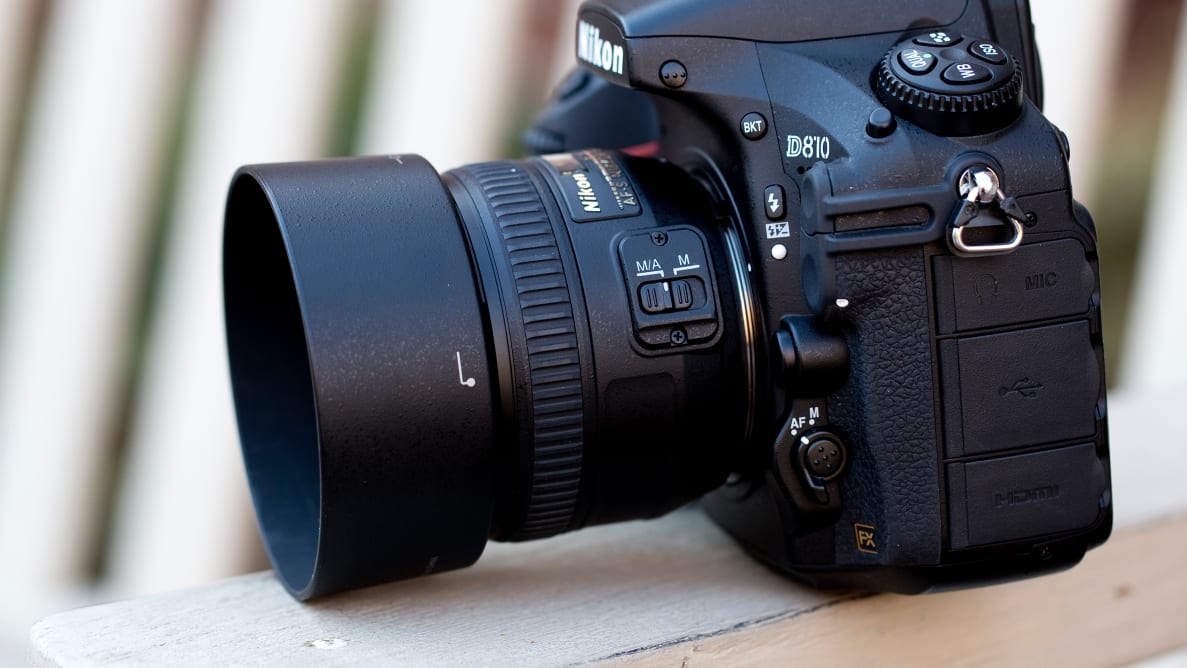But one thing unites nearly all of these disparate systems: a standard 50mm (or equivalent) prime lens.
Though many Nikon shooters opt for the cheaper 50mm f/1.8G (or its elder cousin, the even cheaper 50mm f/1.8D) for their first prime lens, the standard-bearer 50mm for FX shooters is the AF-S 50mm f/1.4G (MSRP $484.95). Tack-sharp with quick and quiet autofocus, this normal prime is a capable option for a wide variety of shooting situations, and can muscle through even in very poor lighting conditions.
But is it the best 50mm Nikon has to offer? Given that the company actively manufactures seven 50mm prime lenses—or eight, if you count the legendary 58mm f/1.4—that’s a really tough question. But after spending some quality time with the lens in and out of the lab, in terms of price versus performance, we’re inclined to call this the most capable all-around 50mm in the Nikon system.
Who's It For?
Nikon’s AF-S 50mm f/1.4G is a wide-aperture "normal" prime lens. Its very large f/1.4 maximum aperture will give you very shallow depth of field, producing beautifully blurred backgrounds behind your subject. It'll also let you shoot handheld even in very dim conditions. And the 50mm focal length (on the full-frame FX DSLRs this lens was designed for, anyway) creates a field of view similar to what your eyes normally see, making it a good all-around lens.

Despite its wide aperture and impressive image quality, the AF-S Nikkor 50mm f/1.4G is a relatively compact lens.
It's an ideal choice for shooters who want to do a mix of portraiture, street photography, reportage, and even some landscapes with better image quality and stronger low-light performance than a kit lens can offer.
At a hair under $500, it's also a great value. Budget shoppers will want to consider the less expensive AF-S 50mm f/1.8G, and those with deeper pockets may be tempted by the $1,700 AF-S 58mm f/1.4G or $950 Sigma 50mm f/1.4 Art, but the 50mm f/1.4G strikes a great balance between price, performance, and features.
The AF-S designation means this lens can also autofocus on Nikon’s entry-level DX bodies, which lack their own focus motor, including popular models like the Nikon D5500. The only hitch? It’ll act like a 75mm lens on these cameras, since the smaller sensor only uses the central portion of the image the lens projects. Still, that's plenty useful, especially for portrait work.
Look and Feel
The AF-S 50mm f/1.4G, like most of Nikon’s newer G-series lenses, has a pretty straightforward physical design. Unlike the classic 50mm f/1.4D, the “G" version has no aperture ring, is made primarily of plastic, and includes a built-in Silent Wave Motor (SWM) for quick, quiet focusing.

Like other G-series primes, the 50mm f/1.4 includes a M/A mode that lets you override the autofocus motor with manual adjustments.
Like many other pro-oriented primes, this one doesn’t rotate or extend when focusing, which is a plus when using filters like circular polarizers. It also features a manual focus override switch, letting you use autofocus while still making manual adjustments whenever you want. It's a feature that's especially useful when you're working up close at wide apertures, where even slight movements can dramatically change the point of focus.

The small focus ring is clearly an afterthought—not a surprise in the age of autofocus.
In terms of feel, the lens is a bit more luxurious than the "D" version it replaced. The focus ring turns more smoothly (though it's focus-by-wire), and though it lacks the hard stops of the previous generation there’s feedback to let you know when you’ve hit the limits of the focus range. The throw is short, but it's tuned tightly enough that even small changes are easy enough to make.
Though we have to confess we have a soft spot for old-school metal lenses with aperture rings, Nikon clearly believes in the simplified "G" design. Ultimately, there’s not much to complain about here given the sub-$500 price.
{{ photo_gallery name="tour" }}
Image Quality
In our imaging lab, the Nikon AF-S 50mm f/1.4G impressed us with sharp results at f/1.4 that just continued to get better as we stopped the aperture down—all the way to f/16. When it's paired with a high resolution sensor like the one in the Nikon D810, you can tease excellent results from this lens in all kinds of conditions.

EXIF: 50mm, ISO 200, 1/8000, f/1.4
Sure, it's a tad softer wide open than the best f/1.4 lenses we've tested, and the cheaper Nikon 50mm f/1.8G is a tad sharper in places, there's one crucial dimension where the f/1.4 jumps ahead: bokeh.
The out-of-focus areas you can get from the 50mm f/1.4 and its nine-bladed aperture are incredibly smooth, with hardly any defects to spoil the washes of color and lovely, rounded points of light. There's a bit of coma (oval-shaped bokeh) toward the edges of the frame wide open, and it takes on a very slightly squared-off look as you stop down, but on the whole this lens does a stellar job.

EXIF: 50mm, ISO 200, 1/160, f/10
There's more good news, too: Chromatic aberrations (colored fringing) and geometric distortion (bent lines) are minimal, so you won't need to do much work to post-process files from this lens. There may be slightly sharper f/1.4 lenses out there, but this lens could easily serve as your go-to glass the majority of the time.
Below you can see sample photos taken with the AF-S Nikkor 50mm f/1.4G mounted on a Nikon D810. Click the link below each photo to download the full-resolution image.
{{ photo_gallery name="sample" }}
Conclusion
You can’t judge a book by its cover, but you can judge a lens system by the quality of its "fast fifty" prime lens. If your system's lens designers can't nail this one? Good luck producing top-notch lenses with more complex designs.
Though we're smitten with the (larger, heavier, more expensive) Sigma 50mm f/1.4 Art, this Nikon AF-S 50mm f/1.4G is a very good choice. It's got superb corner to corner sharpness at even very small apertures, excellent bokeh, and a no-nonsense design and build. Best of all, its sub-$500 price point makes it accessible even to beginners, even if many will still opt for the cheaper 50mm f/1.8G.

The AF-S 50mm f/1.4G offers spectacular bokeh and edge-to-edge sharpness that make it a must-have for all Nikon shooters.
The 50mm focal length is the closest any prime gets to being a generalist, which means it's not fine-tuned to excel at any one kind of photography. If you have more specific needs, you may want to opt for something more specialized: the 85mm f/1.8G for portraits, the 12-24mm f/2.8 for landscapes and architecture, etc.
But there’s really no end to what you can accomplish with a 50mm lens like this. It asks you to make fewer compromises than nearly any other focal length, and plenty of photographers have done their best work with a 50mm. Simply put, there's a reason even seasoned pros keep a 50mm lens in their bag—you never know when it’ll come in handy.
It might not be quite as affordable (or as sharp wide open) as the f/1.8G, but it offers superior bokeh and is just as sharp stopped down. And compared to the king’s ransom you'd have to pay to get a 35mm f/1.4 lens from Nikon, $485 feels like a bargain. No matter what Nikon DSLR you're shooting with, this lens should be one of the first you pick up. When evaluating any lens, we focus on four key areas: sharpness, distortion, chromatic aberration, and bokeh. A perfect lens would render the finest details accurately, wouldn’t distort straight lines or produce ugly fringing around high-contrast subjects, and would create smooth out-of-focus areas.
The designers behind the Nikkor AF-S 50mm f/1.4G had to balance two opposing forces: the drive to create a lens that's as sharp as possible, and the softening effects of an f/1.4 maximum aperture.
The result is that the 50mm f/1.4 isn't quite as sharp as the less expensive, simpler Nikkor 50mm f/1.8G at its widest aperture settings. But by f/4 they're equally, incredibly sharp from edge to edge. There's other good news, too: the lens produces minimal distortion and chromatic aberration with bokeh that is simply to die for.
Sharpness
A lens's sharpness is its ability to render the finest details in photographs. In testing a lens, we consider sharpness across the entire frame, from the center of your images out to the extreme corners, using an average that gives extra weight to center performance. We quantify sharpness using line widths per picture height (LW/PH) at a contrast of MTF50.

Stopped down to f/8, pictures are commendably sharp.
The Nikon 50mm f/1.4G has a typical performance profile for a fast prime lens. As tested on a Nikon D810 in our labs, at f/1.4 it's sharp in the center of the frame (resolving around 1,500 lines) but softer (around 1,000 lines) in the corners. Compared to many prime lenses mounted on a D810, those results aren't stellar, but they're good enough.

At full wide, this lens is a bit lacking.
As you stop down the aperture, center performance steps up considerably, peaking at 2,450 lines at f/8. The corners also improve dramatically as soon as you move past f/1.8, topping out at well over 2,000 lines around f/8. Even at f/16, the performance is remarkably good—2,000 lines across the frame. That makes this lens an excellent choice for landscapes and product photography, as even the smallest details will be accurately rendered.
Distortion
We penalize lenses for distortion when they bend or warp images, causing normally straight lines to curve.
There are two primary types of distortion: When the center of the frame seems to bulge outward toward you, that’s barrel distortion. It's typically a result of the challenges inherent in designing wide-angle lenses. When the center of the image looks like it's being sucked in, that’s pincushion distortion. Pincushion is more common in telephoto lenses. A third, less common variety (mustache distortion) produces wavy lines.
As we'd expect from a 50mm "normal" prime lens, the AF-S 50mm f/1.4G handles geometric distortion well. In our labs, we saw about 1.55% barrel distortion—actually a little more than we typically see in this class, but well within acceptable bounds and easily correctable with photo editing software.
Chromatic Aberration
Chromatic aberration refers to the various types of “fringing” that can appear around high contrast subjects in photos—like leaves set against a bright sky. The fringing is usually either green, blue, or magenta and while it’s relatively easy to remove the offensive color with software, it can also degrade image sharpness.
While there's some chromatic aberration evident in our test shots, it's well-corrected compared to some other fast primes and certainly within normal tolerances. Color fringing is most visible near the corners, especially at f/1.4 and f/2, but it's easily correctable with some minor post-production work.
Bokeh
Bokeh refers to the quality of the out of focus areas in a photo. It's important for a lens to render your subject with sharp details, but it's just as important that the background not distract from the focus of your shot.
While some lenses have bokeh that's prized for its unique characteristics, most simply aim to produce extremely smooth backgrounds. In particular, photographers prize lenses that can produce bokeh with circular highlights that are free of aspherical distortion (or “coma”).
As you can see below, the 50mm f/1.4 produces a bokeh with a nice, consistent shape across the board. These are usually quite round, but certain points of light can take on a football shape near the corners (visible below). These points also have a slight highlight around the edges, though it's so minimal that it doesn't cause too many problems.

While the Nikon 50mm f/1.4G doesn't blow by the cheaper Nikon 50mm f/1.8G in most performance metrics, it absolutely crushes it in terms of the quality and character of its bokeh. If we're nitpicking it can occasionally look a little on the busy side, visible in the shot below where the flags in the background take on a "jittery" effect. But that's the only thing separating this lens from the very best bokeh we've seen.

EXIF: 50mm, ISO 200, 1/8000, f/1.4
The 50mm f/1.4 produced consistently smooth bokeh across most of the frame, with only minor aspherical distortions. This blur is only distracting when high frequency, high contrast patterns are involved—something even so-called "cream machines" can struggle with. If you want an affordable Nikon lens that can produce beautiful out-of-focus areas while isolating your subject, this is the one to get.
Meet the tester
TJ is the former Director of Content Development at Reviewed. He is a Massachusetts native and has covered electronics, cameras, TVs, smartphones, parenting, and more for Reviewed. He is from the self-styled "Cranberry Capitol of the World," which is, in fact, a real thing.
Checking our work.
Our team is here for one purpose: to help you buy the best stuff and love what you own. Our writers, editors, and lab technicians obsess over the products we cover to make sure you're confident and satisfied. Have a different opinion about something we recommend? Email us and we'll compare notes.
Shoot us an email


